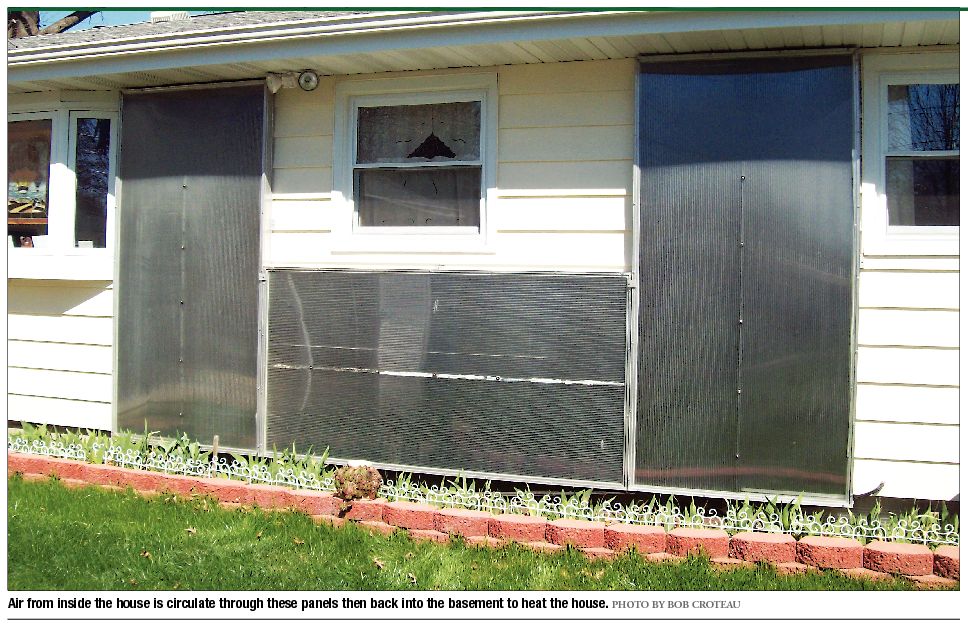
Renew your home with solar and wind 
continued from page 13
Professional site assessors use a solar pathfinder tool, which gives a 360-degree image of the shading at a particular spot superimposed over gridlines of the sun’s path throughout the day and the year. A photograph of the shaded gridlines can be downloaded into a software program that calculates the total amount of sunlight the location receives over the year. A Google satellite image of your property, along with a shot from the south, can also tell site assessors whether it’s suitable for solar.
Marley says solar power got a bad name in the 1970s because people who weren’t qualified got into the business. “Some of the site assessors who came in in the early 1980s would put solar panels anywhere,” adds Croteau, even in total winter shading. This time around, training courses across the country are turning out certified professionals to prevent a repeat of the past. Marley received her certification from the Midwest Renewable Energy Association in Wisconsin, which offers the best training in the country outside California. The first thing a certified professional will do is make sure the house is as energy efficient as possible to minimize the size and expense of the renewable system required.
Croteau also cautions people to be wary of cheap solar photovoltaics from China. “Chicago Electric is one brand,” he says. “It sells a 145watt solar panel kit that just runs a couple of light bulbs. It’s totally made in China, but they use a Chicago name to make it sound American.” And he says flexible photovoltaic laminates that can be attached to roof shingles, which are the latest fad, are overpriced.
Wind generators. “Ideally you’d have both wind and solar, if you could,” says Croteau, noting that wind can supply electricity as solar photovoltaics do, and they complement each other weatherwise. But most people, especially in town, don’t have good wind access. “If you don’t get your wind generator up high enough, the turbulence from the surrounding structures and trees are going to just tear it up and you’re going to have a maintenance headache.” A height of 100 feet is the “sweet spot” for wind generators because that’s where the wind is steady.
He considers many generators on the market with 30-foot towers useless “toys” that only spin in all directions. Wind generators on vertical axes, which have recently become popular, are also nothing but “lawn ornaments.”

Furthermore, “anyone
trying to sell you a wind generator to mount on your roof – that’s a
hangup call,” he warns, pointing out that it will transmit vibrations
through the house and possibly damage the roof.
house and possibly damage the roof.
Springfield city
ordinance requires wind towers to be at least 25 feet from any structure
and Sangamon County mandates they be at least 110 percent of their
height from buildings and property lines. So you’d have to have a lot of
space to accommodate one. Croteau recommends buying a proven wind
generator, such as the 20 kW Jacobs on a 100-foot tower or the 10 kW
Bergey on an 80-foot tower. Wind generators including installation start
at $16,500 for 1 kW and $60,000 for 10kW.
Avoid
buying cheap systems online. “If you get something cheap, it probably
is,” Croteau says. “Low-cost wind is much harder to find than low-cost
solar.”
Smaller
options. If the expense of these systems is too much for you after
taking the federal tax credit, state rebate [see sidebar page 15], and
grants into consideration, you could start even smaller with a $100-$250
passive solar oven. When it’s too hot in the kitchen in summer, you can
bake outside using the power of the sun streaming into the glass window
of the oven. The ovens typically heat to 350 degrees and cook rice in
an hour and a half or a turkey in five hours.
You
could also add a sunspace or greenhouse to the south side of your house
to incorporate passive solar energy into your home. Or simply add or
enlarge windows on the south side. And there are many more options for
people building a new home, such as passive solar features like
clerestory windows and thermal walls. There are a multitude of ways to
let the sun shine in.
Karen Fitzgerald is a freelance writer living in Pleasant Plains. She can be reached at [email protected].